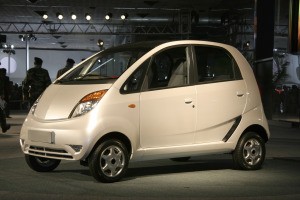 Imagine yourself a scooter. And 30-year man on it. And a woman behind him. And two kids behind her (yes, still on the same scooter). Cuddled tight against each other, they set off and drive through crowded, noisy street.
Imagine yourself a scooter. And 30-year man on it. And a woman behind him. And two kids behind her (yes, still on the same scooter). Cuddled tight against each other, they set off and drive through crowded, noisy street.
When Ratan Tata saw such situation, he decided to do something about it. People, no matter what their social position is, deserve some dignity! So he thought up a solution: the cheapest automobile ever, car for the people.
History of his failure provides excellent insight into consumer psychology, comments Shamim Akhtar from Mizoram University.
Marketing Fairy Tale about perfect car
It was supposed to be an ideal product, consumers’ dream fulfilled; cheap, cute, safe and good-quality car. Tata Motors is a market leader: biggest vehicle producer in India, fourth in the world, with over 60 years of experience in automotive.
It was a classic example of restrictions (future price mainly) leading to innovations. Group of experienced engineers designed optimal car.
So why didn’t sales reflect it?
Logic is sometimes false, or why wouldn’t you want a car?
Tata assumed that every bike or scooter owner dreams about possessing a car, but just can’t afford it. The only barrier is cost of a car, so if we create one that costs as much as 3 scooters, the poor will buy it immediately. Seems legit.
So listen to what real target customers of cheapest car say and why don’t they want it:
- They don’t have a place to park it or garage
- They like their actual means of transportation (smaller, more mobile than a car)
- They are anxious about driving, don’t feel secure behind the wheel
- Relatively high costs of maintenance,
Such problems couldn’t even cross moto giant’s head.
Too expensive for the poor, too cheap for the wealthier
To producers’ surprise, Nano car was mostly purchased by middle class. 80% of buyers have already had one car before. But even in that group Nano was far from success. For them the price was disturbingly low, especially that in India relationship between price and quality is perceived very traditionally as proportional. Nano epitomized then low social status.
Saving on marketing
Is a car safer or more convenient than a bike? Do high price always mean high quality? That could be open to discussion. Introducing Nano would be an excellent opportunity, if anyone was willing to start debating. From our perspective we could say that Lead Nurturing was missing: campaign addressed to various users, providing knowledge and responding to skepticism could show product as something what it actually is: a good car.
Marketing means communication with customers, informing about possibilities of our product, resolving doubts, answering questions.
Lessons about customer psychology from Tata Motors
- Don’t trust your intuitions – do research
- Don’t assume that your customer is just like you, that you share ideas, mindset, and values. Instead, try to listen: interpret his signals, talk to him, run tests. Use all feedback possible: social media, customer service, Marketing Automation analytics
- Customer education is a must: saving on marketing, because your product is great and doesn’t need it, will backfire
- Product needs specific target. It’s not like: “Somebody will love it, if not these, then those”.
- Lowest possible price isn’t always the best idea.
(Read more: Shamim Akhtar, Behind the Nano Mistakes: A Case Study on Consumer Psychology, Srusti Management Review, Vol. VI, Issue I, January 2013)
 Follow
Follow
















